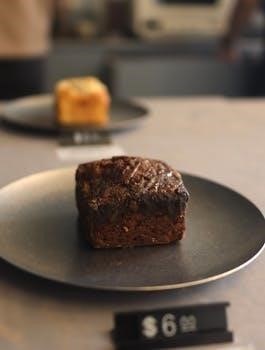Determining the correct price for a cake can be a challenge, especially for those new to baking․ This guide explores how to accurately price your cakes, ensuring your work is valued correctly․ It involves more than just ingredient costs․
Why Cake Pricing Can Be Tricky
Pricing cakes is often difficult for beginners due to the many factors involved beyond just the cost of ingredients․ It requires balancing material expenses with the time and effort spent on baking and decorating․ Unlike other products, cakes often involve customization, which adds another layer of complexity․ It’s not simply about covering costs; it’s also about valuing the baker’s skills and creativity․ Additionally, factors like overhead, packaging, and delivery must be considered․ Accurately accounting for all these elements and determining a fair price for a homemade cake can be a challenging task, especially at the start of your baking journey․

Key Factors Influencing Cake Prices
Several key elements determine the final cost of a cake․ These include the quality of ingredients, the size and number of servings, and the complexity of the design and customization requested․
Ingredient Costs and Quality
The expense of ingredients significantly impacts the overall cake price․ Using high-quality items, such as organic flour, premium chocolate, and fresh, seasonal fruits, will naturally increase your costs․ These superior ingredients enhance the cake’s flavor and texture․ It is very important that you meticulously track the cost of each component, including sugar, butter, and any special additions․ Remember that higher-quality inputs not only contribute to a better final product but also justify a higher price․ Accurately accounting for these costs is essential for profitable cake pricing․ The type of ingredients you select will play a huge role in the final price of your cakes․
Cake Size and Servings
The size of the cake directly correlates with its price․ Larger cakes, which naturally require more ingredients, will cost more․ The number of servings a cake provides is a significant factor for customers, especially for events․ Cakes for weddings or large celebrations may require multiple tiers, which increases both material and labor costs․ When determining your prices, consider the standard size options and how many portions they yield․ Providing clear information about serving sizes helps customers understand the price difference between various cake options․ A clear pricing chart will help you․
Design Complexity and Customization
The intricacy of a cake’s design significantly impacts its price․ Highly customized cakes with detailed decorations, such as intricate sugar work, handmade figurines, or elaborate piping, demand more time and skill․ 3D cakes, which require special techniques and structures, are more costly than standard 2D cakes․ The amount of modeling involved can also increase the price; Customers who desire specific themes or unique designs should expect a higher price due to the extra effort and expertise involved; Clearly communicate how customized design elements add to the overall cost of the cake․
Calculating Your Costs
Accurately calculating costs is essential for profitable cake pricing․ This involves understanding ingredient expenses, labor, and overhead․ Tracking these elements helps determine a fair price for your creations․
Ingredient Cost Calculation
Calculating ingredient costs involves more than just the price of flour and sugar․ You must track every item, from the main components to small additions like sprinkles, toppers, and even packaging․ To do this accurately, determine the cost per unit of each ingredient, such as per cup of flour or per ounce of chocolate․ Then, calculate the quantity used in each cake and multiply it by the cost per unit․ This meticulous approach helps ensure you don’t underestimate the true cost of the ingredients used; Remember to include variable costs, which can change based on how many cakes you are making․
Labor Costs and Hourly Rate
Calculating labor costs requires careful consideration of all the time spent on a cake, not just the baking and decorating․ This includes time for planning, consultation, sketching, shopping, cleaning, and marketing․ Determine a fair hourly rate for your time, reflecting your skills and experience․ Then, estimate the total time spent on each cake, from start to finish․ Multiply this time by your hourly rate to find the total labor cost․ This ensures you are compensated for every aspect of cake creation and business management․ Remember, your time is valuable․
Overhead Expenses
Overhead expenses are the indirect costs of running your baking operation, and they are essential to consider when pricing cakes․ These include costs like electricity, equipment depreciation, and packaging materials such as cake boards and boxes․ Unlike ingredient costs that vary, overhead costs are more constant․ Calculate these costs over a set period, such as a month, and then divide by the number of cakes you make to determine a per-cake overhead cost․ Ignoring these expenses can lead to underpricing your cakes and loss of potential profit, so accurate accounting is key․

Pricing Strategies
Several methods exist for pricing cakes, including itemization, pricing per model or hour, and setting a base cost per size․ Selecting the right strategy impacts how you value your time and materials․
Itemization Method
The itemization method involves breaking down each component of the cake into separate costs․ This detailed approach allows you to account for every element, from ingredients and packaging to special decorations․ By pricing each part individually, you ensure that nothing is overlooked, providing a transparent breakdown for your customers․ This method can also be very useful for understanding where your costs are accumulating․ This will allow you to make adjustments to your recipes and processes to keep costs down․ Consider that labor costs should also be included in this calculation as well․
Pricing per Model or Hour
Pricing per model involves setting a price based on a specific cake design or size․ This method works well when you have a set catalog of cakes with established recipes and decoration styles․ Alternatively, you can price by the hour, which is useful for highly customized or intricate designs․ You should track your time closely to ensure you are charging a fair rate․ This ensures you are paid fairly for your time and skill․ The hourly rate should be a reflection of your experience and expertise in cake decorating․ This is a good approach for custom designs․
Setting a Base Cost for Different Sizes
Establishing a base cost for various cake sizes is crucial for efficient pricing․ This involves calculating the ingredient costs and labor for a standard cake of each size․ This will create a framework for pricing your cakes․ Begin by determining the cost to make the cake, then add in your labor expenses․ With a base price, you can add additional charges for complex designs, unique flavors or additional customizations․ This method also helps simplify quoting for tiered cakes since you will have a base for each individual tier․ This is a great foundation for your pricing strategy․

Using a Cake Pricing Calculator
Cake pricing calculators are useful tools that help bakers determine the right price for their creations․ They factor in costs, labor, and profit margins to ensure fair pricing․
How Calculators Help Determine Price
Cake pricing calculators streamline the process of calculating costs by considering multiple factors․ They help bakers avoid underpricing by accurately tallying ingredient expenses, labor time, and overhead costs, such as electricity and packaging․ These tools often allow for the input of hourly rates and desired profit margins, providing a comprehensive price․ By using a calculator, bakers can confidently price cakes, ensuring they cover all expenses and earn a fair profit․ This prevents guesswork and provides a structured approach to pricing, leading to a more consistent and profitable business․ Calculators also aid in tracking time spent on each cake, allowing for better resource management․
Free Cake Pricing Calculator Tools
Numerous free online cake pricing calculators are available, offering bakers an accessible way to determine cake prices․ These tools often come in the form of spreadsheets or web applications․ They typically allow users to input the cost of ingredients, labor hours, and other expenses․ These free calculators can also help bakers factor in profit margins and delivery costs․ Many of these free resources offer templates that can be easily customized, making them valuable for home bakers and small businesses․ By using these tools, bakers can ensure they are charging fair and profitable prices without the need for complex manual calculations․ They are also great for beginners․

Additional Pricing Considerations
Beyond basic costs, factor in delivery and packaging expenses, such as boxes and toppers․ A crucial element is setting a suitable profit margin, which ensures your business is sustainable and allows for growth․
Delivery and Packaging Costs
When establishing your cake prices, it’s vital to account for all the costs associated with getting your cake to the customer safely and presentably․ This includes more than just the obvious ingredients․ Think about the cost of cake boxes, boards, and any decorative packaging like ribbons or toppers․ Also, consider the expenses related to delivery․ This could be the cost of fuel if you’re delivering it yourself, or the fees charged by a delivery service․ These expenses, although seemingly small, can add up significantly․ Therefore, it is essential to include them in your pricing to ensure you are not losing money on each order․ Remember, a professional presentation enhances the perceived value of your cake․
Profit Margin
Setting a suitable profit margin is crucial for the sustainability of your cake business․ This is the percentage of revenue that remains after all costs, including ingredients, labor, overhead, delivery, and packaging, have been deducted․ Your profit margin ensures that your business earns a reasonable income․ It’s not about excessive pricing; it’s about creating a balance between the value you provide and the financial sustainability of your business․ A well-calculated profit margin also allows for reinvestment in your business, such as upgrading equipment or expanding your offerings․ Consider your market and desired income when determining the appropriate margin․ This will help you create a fair and profitable pricing structure․

